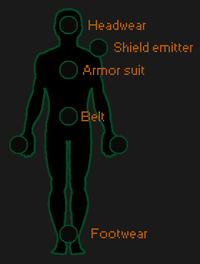Armor
- For a list of armor items, see Category:Armor.
Armor in Underrail reduces damage via one of two mechanics, percentage-based damage resistance (DR%) or flat damage threshold (DT). Since version 0.1.14.2, armor resistances are capped at 95%.
When you take damage, your armor will either reduce it by the amount specified by the damage resistance or by the flat amount specified by the threshold, whichever is greater, not both.[1]
Thus, higher DT is better against faster attacks that deal less damage (such as SMGs, knife attacks, etc), while higher DR% is better against heavy attacks (snipers, sledgehammers, etc).
Armor Penalty is another important property of all armors. It reduces a percentage of your Stealth, Evasion, Dodge skills and Movement Points. The heavier the armor is, the more armor penalty it has. Total armor penalty is capped at 95%.
Armor slots
Headwear
In addition to helmets and balaclavas, useful gadgetry like Goggles and Psionic Headbands can be worn on head. Headwears are craftable and have durability.
Shield emitter
Shield emitters provide your character with an energy shield when powered. Shield emitters are craftable but have no durability. Instead, they use electrical energy.
Armor suit
The main piece of your protective armor, encompassing your character from shoulders to ankles. Most armor suits are craftable and have durability, but there are also special armor suits that have no durability and are not craftable.
Belt
Belts grant extra utility slots and various other bonuses. Belts are not craftable and have no durability.
Footwear
Boots provide additional protection and can improve your movement speed and melee performance. Footwear are craftable and have durability.
Types
Armor in Underrail can be roughly split into three types - light, medium and heavy. These are not set-in-stone limitations, but rough examples of different playstyles. Mixing and matching different types is possible and encouraged.
Light armor
Light armors are characterized by zero or light armor penalty and bonuses stealth, movement and dodge/evasion.
Medium armor
Medium armors are characterized by specialized bonuses and medium armor penalty that allows a mix of stealth, mobility, damage avoidance and absorption as defense.
Heavy armor
Heavy armors are characterized by heavy armor penalty, heavy weight and greatest damage resistances.
Durability
Since version 0.1.7.0, most armors and weapons have durability. This means you must periodically use repair kits to keep your gear in working order. Once an armor's durability has been degraded enough, your UI will notify you that you have Damaged Armor and the armor will provide reduced bonuses, or no bonuses at all in case of Heavily Damaged Armor. Armor that has reached heavily damaged status or zero durability provides no bonuses, but they can still be repaired back to normal. Any equipped heavily damaged armor still provides any penalties it may have.
